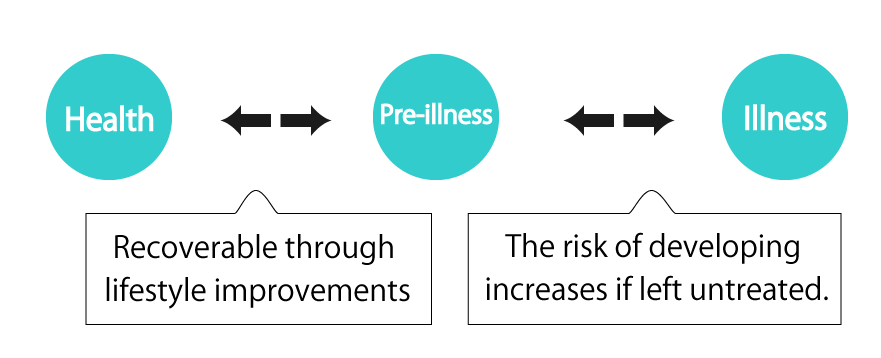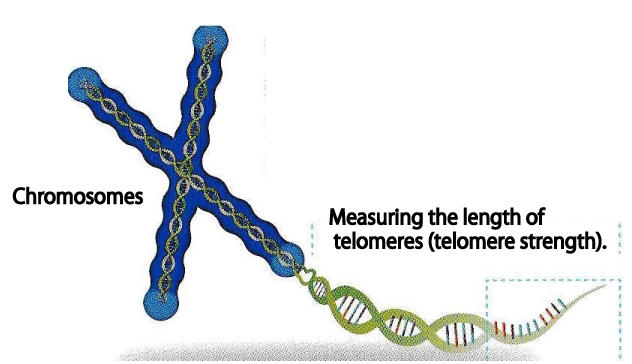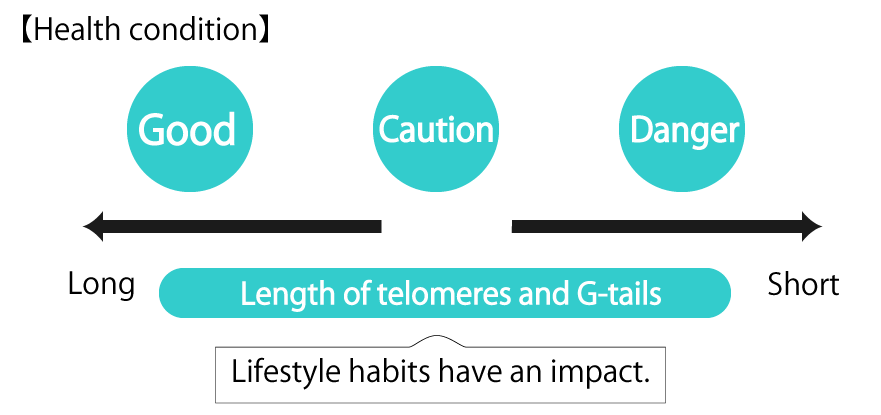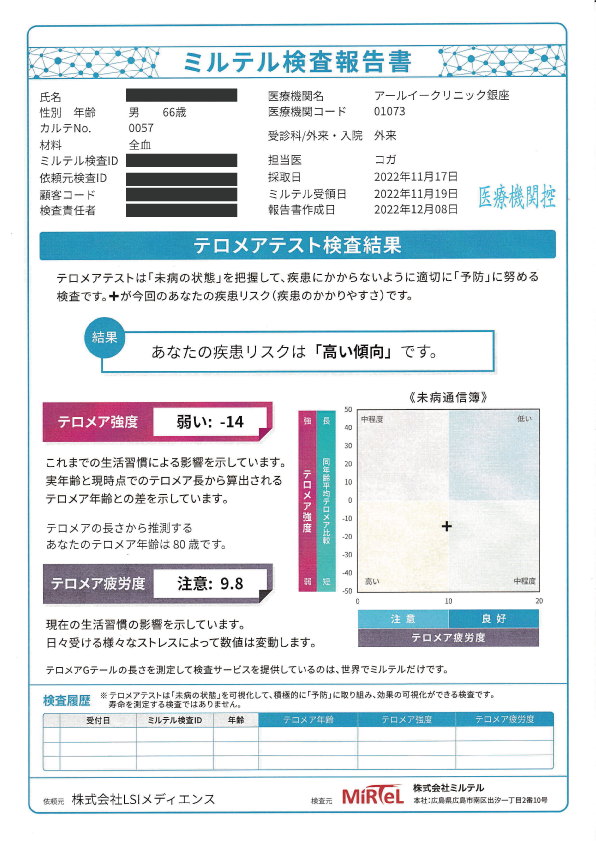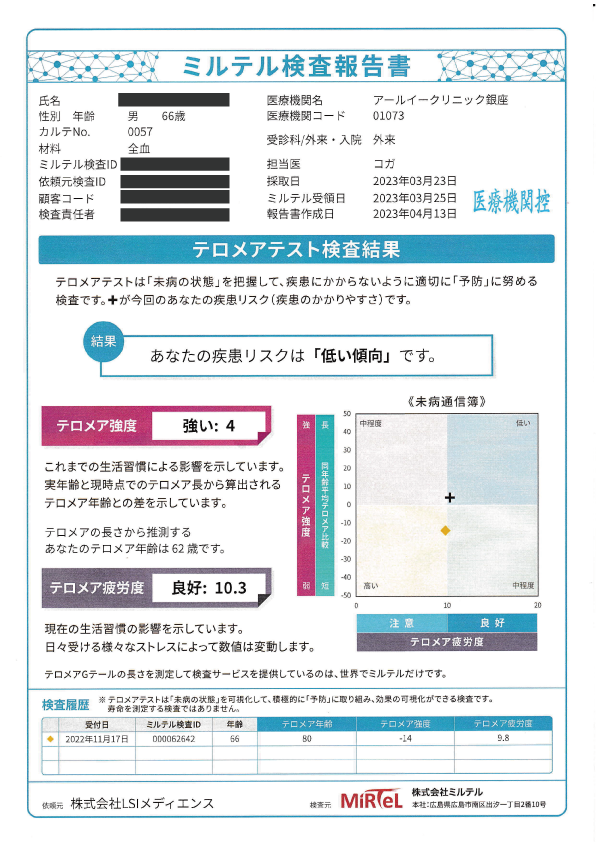Telomere testing
What is Telomere testing
Telomere testing is an examination that measures the length of telomere sequences at the ends of chromosomes. It measures two lengths: the overall length of the telomeres and the length of the single-stranded portion at the end called the “G-tail.
What is Telomere
Telomeres are the portions located at the ends of chromosomes that shorten with each cell division. Their length is associated with aging, lifespan, and even the strength of genes. Research has shown that individuals with shorter telomeres are more prone to various age-related diseases. The “G-tail” is a single-stranded portion extending like a tail at the end of the double helix structure. It shortens due to environmental stressors, allowing us to assess the “fatigue level” of genes through testing. We measure the “gene age” by assessing the (genetic strength) relative to the actual age.
We have entered an era where it is possible to test for signs of illness.
A new concept of checking for pre-disease conditions.
Are you familiar with the concept of “pre-illness” (mibyo)? Pre-illness refers to a state between health and illness, characterized by mild symptoms that do not lead to the onset of a disease. Telomere testing can detect this pre-illness state.
■Treating Pre-Illness to Achieve Health
“Pre-illness” is said to have been first mentioned in the ancient Chinese medical book “Huangdi Neijing,” over 2000 years ago, with the statement “a sage treats pre-illness.” In modern times, where even if you don’t feel unwell, tests can reveal deterioration in health, the idea of actively treating pre-illness has become increasingly important.
Recommended for:
・Those concerned about their health status
・Individuals who want to manage their physical condition and health diligently
・People who often feel sluggish or easily accumulate fatigue
・Those who feel generally unwell
・Individuals who regularly experience stress
・People who are at risk of lifestyle-related diseases
・Individuals undergoing treatment for lifestyle-related diseases and are concerned about exacerbation
Understanding Health at the DNA Level
Telomere testing is an advanced blood test that reveals the health status at the DNA level by measuring “telomere strength” and “telomere fatigue.” This test identifies the risk of hidden diseases.
What can be understood from telomere strength
How has your lifestyle been so far?
➡Telomere strength reveals how the lifestyle habits you have accumulated so far influence the inherent strength of your genes.
What can be understood from telomere fatigue
What is your current lifestyle like?
➡Telomere fatigue reveals the level of stress on your genes at present, allowing you to understand whether you are currently in a healthy state or approaching a state closer to illness.
★World’s Only Test of Its Kind
Telomere strength and telomere fatigue can be determined by measuring the length of “telomeres” and the length of the “G-tail.” However, currently, the only test in the world that can measure the length of this “G-tail” is the telomere test.
By measuring the lengths of telomeres and G-tails, one can determine telomere strength and telomere fatigue, revealing the health status at the DNA level.
Telomeres are located at the ends of chromosomes in the cell nucleus and serve to protect genes.
Basic Knowledge of Telomere Testing
The lengths of “telomeres” and “G-tails” are the key factors.
The key to understanding the health status at the DNA level lies in the lengths of “telomeres” and “G-tails.” Longer telomeres and G-tails are associated with good health status, while shorter ones are considered to pose a risk of illness.
Measuring the length of the G-tail (telomere fatigue):
Human DNA is linear with ends, and the DNA at the end of the chromosome is called “telomere,” while the single-stranded portion at the very end of the telomere is referred to as the “G-tail.”
Lifestyle Habits Influence
Telomere testing reveals telomere strength from telomeres and telomere fatigue from G-tails, but the results of both are influenced by lifestyle habits. Improving lifestyle habits also contributes to maintaining and enhancing health at the DNA level.
In particular, the G-tail expands and contracts significantly due to environmental factors such as stress, whereas visible changes in telomeres may occur over the span of years, the G-tail changes on a weekly basis.
Key Points to Note: Telomeres
Shortens with aging
While there are natural individual differences in the length of telomeres, they shorten with each cell division, leading to shortening with aging. Additionally, the rate of shortening varies depending on environmental factors.
Short telomeres are associated with a higher risk of illness.
People with short telomeres are more susceptible to diseases. Moreover, individuals with cancer or lifestyle-related diseases tend to have shorter telomeres compared to healthy individuals.
Key Points to Note: G-tails
Can be extended by environmental improvements
The length of G-tails also shortens with aging and is influenced by environmental factors such as stress. However, it can also be extended by improving the environment.
Persistent shortening increases susceptibility to illness.
It has been found that prolonged shortening of G-tails increases susceptibility to diseases such as cardiovascular disorders and dementia. Additionally, the length of G-tails is known to affect telomere shortenin
To confirm whether one is approaching illness through telomere testing and to prevent the onset of diseases, it is important to improve lifestyle habits. We are now entering an era where we prepare for illness before it occurs.
What is a telomere test…? It’s a pre-illness examination that reveals the health status at the DNA level with just 5ml of blood sampling.
Feature 1: Understand Your Risk of Illness
Telomere testing quantifies telomere strength and telomere fatigue by measuring the lengths of telomeres and G-tails. Telomere strength indicates “susceptibility to illness,” while telomere fatigue indicates “current pre-illness status,” enabling the assessment of the risk of illness.
Examples of diseases considered to have a higher risk
From previous research, it has been suggested that the risk of various age-related diseases increases when telomeres and G-tails are short. The following diseases are believed to have an increased risk:
・Myocardial infarction (heart attack)
・Stroke
・Cancer
・Dementia
Feature 2: A Convenient and Safe Blood Test
While measuring telomere strength and fatigue may sound complicated, telomere testing involves just a simple blood draw of 5ml. Combined with a questionnaire, it is a convenient and safe test that can be completed in just a few minutes.
★Telomere testing is aimed at understanding the pre-illness state. Based on the test results, it is important to review and improve lifestyle habits.
■ Improving Lifestyle Based on Test Results
Even if you don’t feel any discomfort, if the results of the telomere test show unsatisfactory telomere strength and fatigue levels, it is believed that you may be approaching illness. At this stage, improving lifestyle habits can help prevent the onset of disease.
■ Regularly Monitor Your Health to Track Changes
Telomere fatigue is susceptible to fluctuations due to lifestyle habits. By undergoing testing every six months to a year, you can understand changes in the pre-illness state from within the body.
★ Invest in Your Health with Telomere Testing…
Telomere testing serves as a report card for your pre-illness state. Even if you are determined to have a high risk of illness, improvements in lifestyle habits can also enhance the pre-illness state. Instead of waiting until illness strikes and investing significant time and money into treatment, the era now emphasizes checking health status at the pre-illness stage and maintaining health. Utilize telomere testing effectively as an investment in your health.
Test results
The process from testing to results.
01.Reservation
Please contact a medical institution affiliated with MIRTEL to schedule a blood draw.
02.Blood Draw
Only about 5ml of blood will be drawn. With the questionnaire, the process will take only a few minutes to complete.
03.Testing and Analysis
The blood samples received at the MIRTEL Testing Center will be analyzed.
04.Result Notification
Approximately one month after the blood draw, the results will be returned through the affiliated medical institution where you were examined.
※Please visit our website for contracted medical institutions.https://www.mirtel.eo.jp/service/search/
Q&A
Q: How much does the test cost?
A: Please inquire at a medical institution affiliated with MIRTEL.
Q: Are there any dietary restrictions for the test?
A: This test is not affected by diet, but some individuals may experience difficulty with blood sampling. Therefore, we recommend fasting for one hour before the test.

